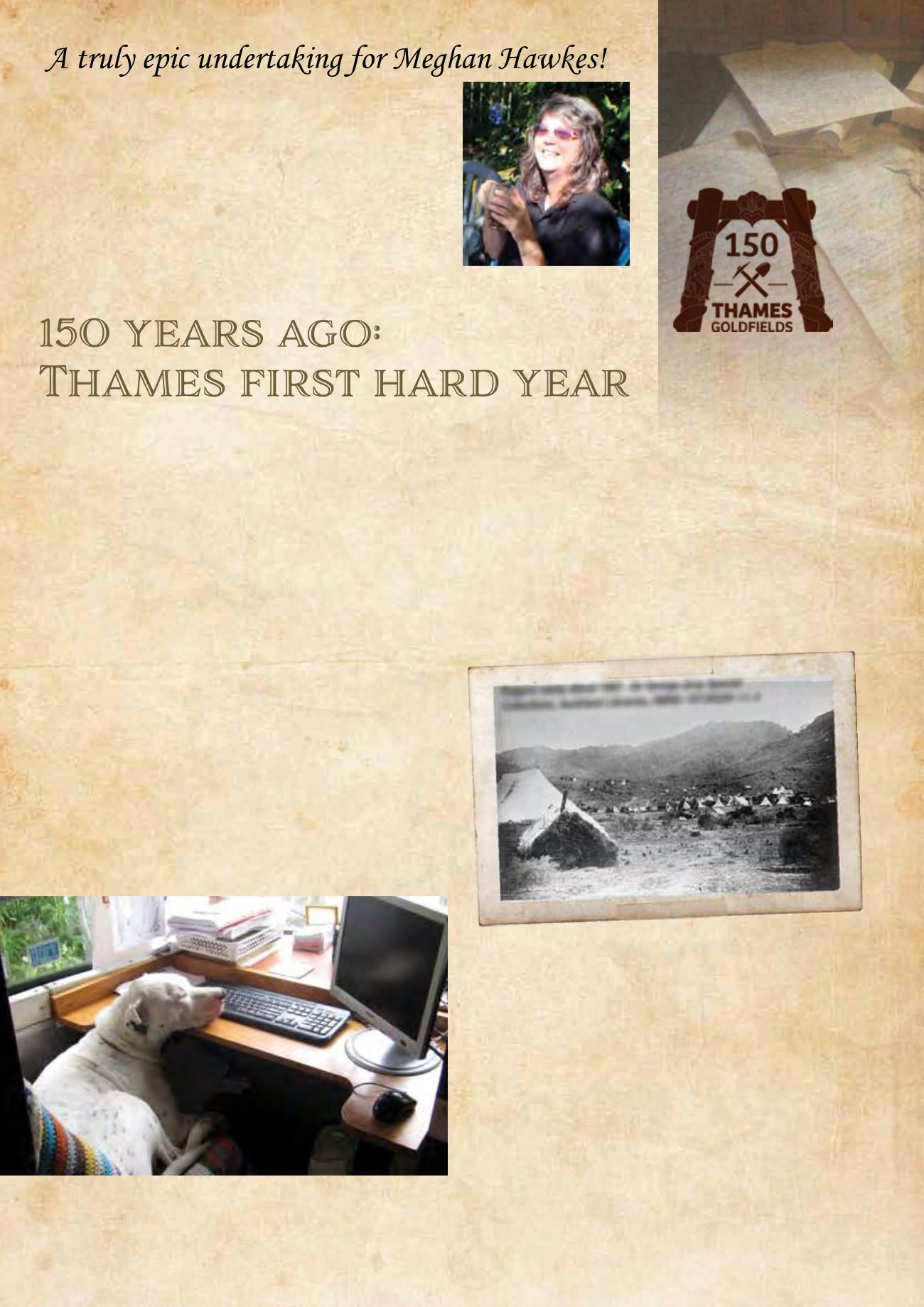

Meghan Hawkes, author of five historical books about the Thames
area, was the perfect writer to take on the challenge to chronicle
the day-to-day history of the first year of the Thames Goldfields –
its hopeful miners, shop keepers, churchmen, investors, builders
and ordinary people needed to build a thriving mining community.
What a truly epic undertaking! Meghan’s weekly blog has been
part of the Thames 150th commemoration of the opening of the
Goldfields in 1867.
We applaud her mammoth effort to inform and amuse us. If you
haven’t yet read her blog we recommend you do. Meghan will be
continuing her entries through the end of July. See
www.firstyearthamesgoldfield.co.nzBy Meghan Hawkes
Meghan’s working space is not any ordinary office, but the small corner of a
house bus where this passenger seat is a desk, with a real desktop computer. “It
is from here I immersed myself in life 150 years ago,” says Meghan. “My loyal
research assistant, Sampson, keeps my seat warmed up.”
were often brought up short by the cold hard facts of medical officer,
geologist or police reports. The Southland papers, likely trying to keep
their mining population, continually poured cold water over the hot
news coming from the Thames.
Yet, with no photographs in newspapers at the time, the detailed,
written descriptions were vivid and invaluable.
It has been a fascinating journey for me. When the first official
discovery of gold was made at the Thames, Auckland was in the grip
of a depression. There were empty houses and scores of unemployed.
Trade was bad, money scarce, wages low and work hard to find.
Businesses crashed, one after the other. There had been a land boom,
and it had burst. There was no place to go as 1867’s winter set in.
The first diggers arrived at the Thames in wretched weather. Hills
were covered in tangles of scrub and undergrowth; and on the flat
there was nothing better than raupo swamp and ti-tree scrub. Along
the Kauaeranga Creek was a church misson station and a Maori
settlement of whares and crops. There were few Europeans and only
one store.
The ground officially opened for mining spanned a distance of not
quite two miles. It was mostly covered in peach trees and swamp.
A desolate area, part of which was a Maori burial place, was thickly
studded with carved posts, with leering heads and thrust out tongues,
which the men found unnerving.
AS THAMES’ SECOND YEAR BEGINS,
THE WEEKLY BLOG ENDS
One short year later, there was a town with numerous well built
and commodious hotels, well-filled stores, comfortable cheerful
weatherboard houses, and more than one brick house. The main
thoroughfare, Pollen Street, almost as broad as Auckland’s Queen
‘
The First Year on the Thames Goldfield’, was a huge undertaking which
took two years of research and writing.
My rough blog notes filled six 200 leaf refill pads, some 1200
handwritten pages. A final typed version came to 272,000 words. It
often involved many 4am, and even earlier, starts.
Every Monday for 52 weeks – including Christmas, New Year’s and
other public holidays – the weekly blog was published online, despite
illness, injury and the usual ebb and flow of family life.
It was a daunting prospect – a
Paper’s Past
search for the word
Thames during the years 1867 and 1868 yielded 6,624 results but as
the area was known by other names – Karaka, Waiotahi, Kauaeranga,
Tapu, Shortland, and Grahamstown – these had to be separately
searched as well.
Even then I could not document every claim, schooner, cutter,
steamer, parcel of gold or claim jumping cases, which were countless.
Once the Thames goldfields were opened, there was an avalanche of
news, some of it with conflicting reports. Media beat-up’s are common
today, but the discovery of the Thames goldfield was an early example
of it. The two main players, the
NZ Herald
and
Daily Southern Cross
,
battled it out over the printing presses, producing wildly differing
accounts, which was read by people trying to decide whether to go to
the Thames and risk eveything, or stay put.
The
Daily Southern Cross
took a headily optimistic, and at times
exaggerated approach, while the
NZ Herald
was more cautious, staid
and initially pessimistic. Several of the reporters were miners whose
experiences coloured their reporting. Glowing newspaper accounts
Diggers camp about 1867.
Sir George Grey Special
Collections, Auckland Libraries, AWNS-19130220-11-3
48
COROMANDEL LIFE 2018 WINTER/EARLY SPRING
As you can see, even with a computer
on board, Meghan took copious notes
for each day of the Thames Goldfield’s
first year, writing longhand in these
numerous notebooks.
















